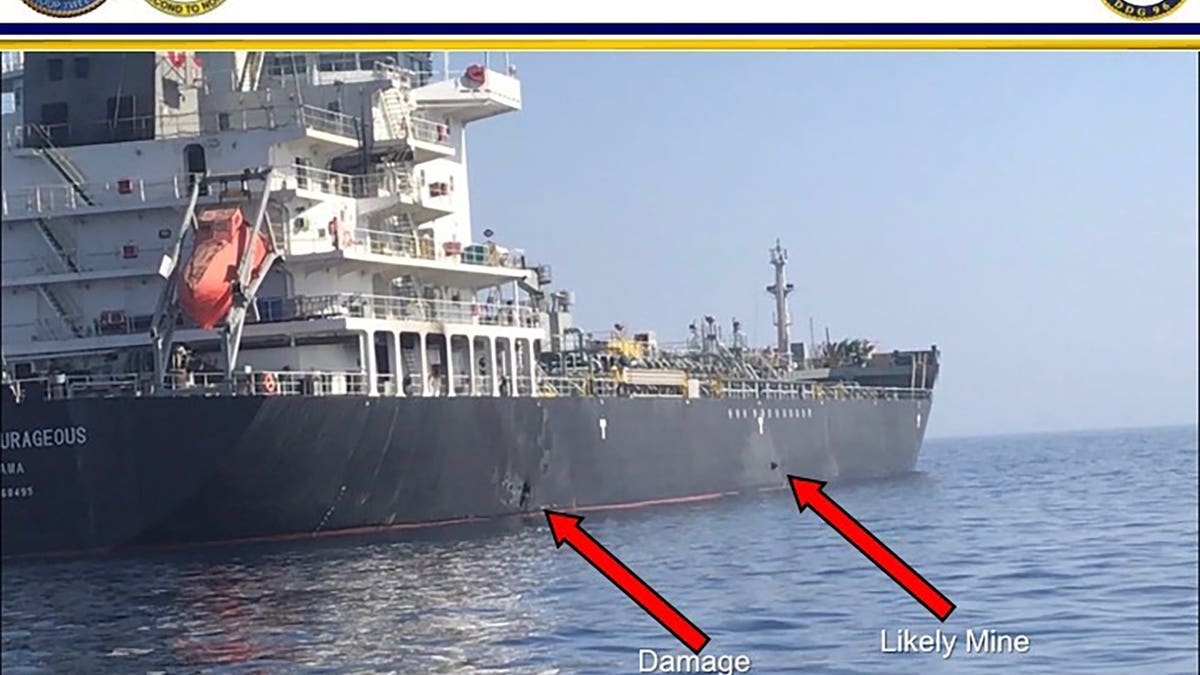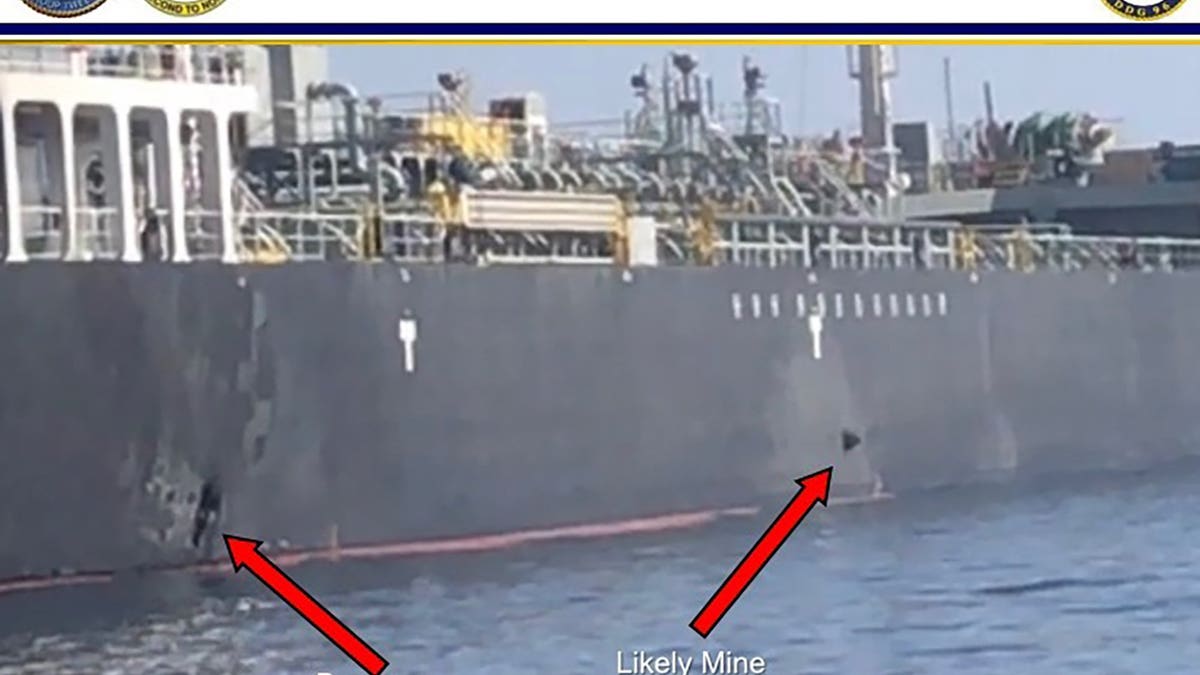Raw video: Iranian vessel removes unexploded mine from stricken oil tanker
The pentagon has released this video of an Iranian vessel removing an unexploded mine from a damaged Japanese-owned oil tanker.
The U.S. blamed Iran for the attacks on oil tankers near the Strait of Hormuz, releasing a video Friday supposedly showing Iran’s Revolutionary Guard removing an unexploded limpet mine from one of the vessels.
The black-and-white footage, as well as still photographs released by the U.S. military’s Central Command on Friday, appeared to show the limpet mine on the Japanese-owned Kokuka Courageous, before a
A Revolutionary Guard patrol boat pulled alongside the ship and removed the mine, Central Command spokesman Capt. Bill Urban said.
At least one other mine attached to the tanker's hull detonated, causing the blast near the strategic Strait of Hormuz, a key route for oil shipments in the region.
But what are the so-called “limpet mines”?

This June 13, 2019, image released by the U.S. military's Central Command, shows damage and a suspected mine on the Kokuka Courageous in the Gulf of Oman near the coast of Iran. The U.S. military on Friday, June 14, 2019, released a video it said showed Iran's Revolutionary Guard removing an unexploded limpet mine from one of the oil tankers targeted near the Strait of Hormuz, suggesting the Islamic Republic sought to remove evidence of its involvement from the scene. (U.S. Central Command via AP)
IRANIAN VESSEL REMOVED UNEXPLODED MINE FROM STRICKEN OIL TANKER IN GULF OF OMAN, US OFFICIALS SAY
The mines got the name from the real limpets, small sea snails that easily cling to hard surfaces and rocks.
The weapon was first developed by the British during World War 2 and is often used in covert action in order to damage ships because they are easily attachable.
There are certain variations, with some detonated by a time fuse while other explode only after the vessel to which the mine is attached travels a specific distance.
In most cases, the mines are magnetic and are easily attachable to the hulls of a ship. They normally just disable rather than sink a vessel.
This wouldn’t the first time Iran used the mines to attack oil tankers. In the 1980s, the “Tanker War” erupted in the midst of the eight-year conflict between Iran and Iraq, threatening to disrupt the global oil supply.
Both countries back then attacked each other oil tankers in the Persian Gulf, with Iran using the limpet mines to cause damage. The conflict prompted then-President Ronald Reagan to intervene and provide protection in the Strait of Hormuz for certain tankers to ensure steady supply of oil.

This June 13, 2019, image released by the U.S. military's Central Command, shows damage and a suspected mine on the Kokuka Courageous in the Gulf of Oman near the coast of Iran. The U.S. military on Friday, June 14, 2019, released a video it said showed Iran's Revolutionary Guard removing an unexploded limpet mine from one of the oil tankers targeted near the Strait of Hormuz, suggesting the Islamic Republic sought to remove evidence of its involvement from the scene. (U.S. Central Command via AP)
TRUMP NOT 'WORTHY' OF RESPONSE, IRAN'S SUPREME LEADER SAYS AS JAPAN'S ABE TRIES TO EASE TENSIONS
President Trump said in an interview with “Fox & Friends on Friday morning that the limpet mine had “Iran written all over it.”
“Iran did do it and you know they did it because you saw the boat,” he said, before pointing to video that the Iranians removing the unexploded mine. “They're a nation of terror and they've changed a lot since I've been president, I can tell you,” he added.
“Iran did do it and you know they did it because you saw the boat.”
TRUMP WARNS IRAN OVER TANKER ATTACK: ‘WE DON’T TAKE IT LIGHTLY’
Secretary of State Mike Pompeo and other U.S. officials suggested the use of mines in the incident implicates Iran because the limpet mines were used in the May attack on four oil tankers near Emirati port of Fujairah.
“This assessment is based on intelligence, the weapons used, the level of expertise needed to execute the operation, recent similar Iranian attacks on shipping, and the fact that no proxy group operating in the area has the resources and proficiency to act with such a high degree of sophistication,” Pompeo said during a press conference on Thursday.
He added that Iran was working to disrupt the flow of oil through the Strait of Hormuz and this is a deliberate part of a campaign to escalate tension, adding that the U.S. would defend its forces and interests in the region, although he did not elaborate.

This June 13, 2019 false-color image from the European Commission's Sentinel-2 satellite that was processed by Sinergise's Sentinel Hub website shows the Norwegian-owned MT Front Altair ablaze with smoke rising from it in the Gulf of Oman after what the U.S. described as a limpet mine attack by Iran. Iran has denied being involved in the incident. The white light in the image is the sun being reflected off the waters of the Gulf of Oman. (European Commission via AP)
Iran's foreign minister, Javad Zarif, denied the accusations and said of the latest incident: "Suspicious doesn't begin to describe what likely transpired this morning."
Iranian President Hassan Rouhani, meanwhile, slammed the U.S. for pursuing an aggressive policy against Iran.
CLICK HERE TO GET THE FOX NEWS APP
While the Iranian leader didn’t mention the tankers, he said the U.S. is "using all opportunities for radicalizing the situation, which undermines the stability not only in our region but in the whole world."
He added that America has been "carrying out an aggressive policy and posing a serious threat to regional stability.
Fox News' Lucas Tomlinson and the Associated Press contributed to this report.





















